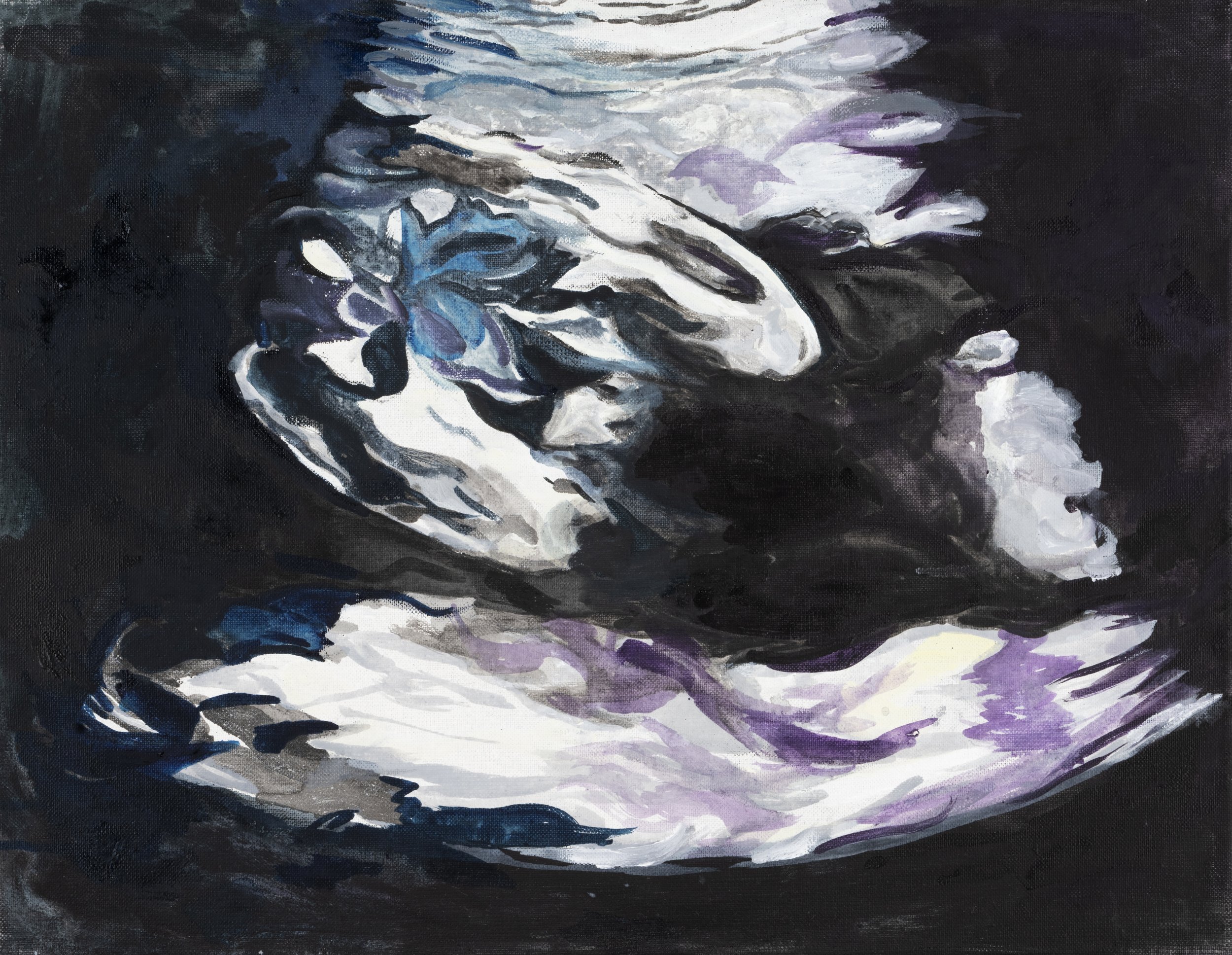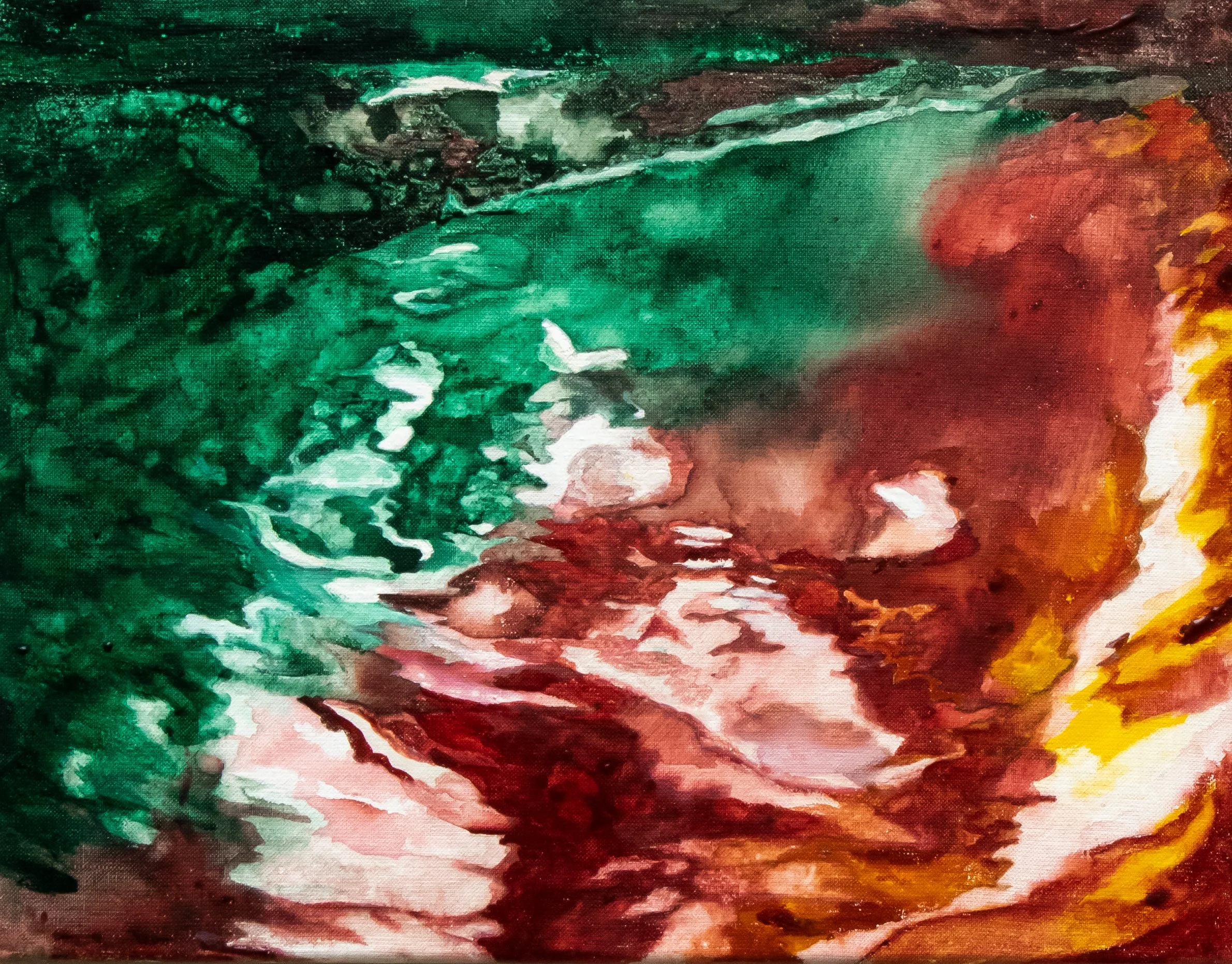Dorothea Stiegemann, Untitled, 2022. Oil on linen, 35 x 45 cm.
Dorothea Stiegemann
Insiders
17th September - 25th November 2022
CLICK HERE to request a copy of the exhibition catalogue
FOREWORD by Fraser Brough, Director, CASSIUS&Co.
This is ostensibly an exhibition about the inner world, about the inside of the female body. The meticulous, intimate paintings that form the basis of the show, with their serial format of 35 x 45 centimetres and their shared, mostly monochrome, palette, are based on images taken from ultrasound screenings, where a sound-based camera is used to look, miraculously, at what is happening beneath the skin. The title is also a double entrendre, because these paintings are equally concerned with the subject of reading images, with who gets to have the ‘insider’ knowledge to understand and translate what they see. It is important to note though, that however much innerness might be here on display, however much introversion in both the physical and psychological senses of that term, these are really paintings with the capacity to open, to expand, to exhibit not something small but something large, the multitudes contained inside.
That is why when I look at these works I do not see dead ends but tunnels, not caves but cavernous halls. The forms are specific but that doesn’t matter because as viewers we can not be sure; spines looks as much like bridges as bones, the top of a head like the bottom of a well, and who would know without being told that this is a tiny, beating heart? A small gush of blood can here have the vastness and the detail of an ocean, and a supine foetus can as easily be a flower or a galaxy. It is only the root of the form that is specific, the painted image is multiplex.
It is perhaps of particular importance to mention this here because that root is so personal, the scans having been taken over a period of years from the artist’s own body. One could read them as intimate details of one person’s life, each a moment of intense emotion that is specific only to the artist’s own history, but that would be to only look at the beginning without thinking about the end. Anyone who has experienced pregnancy will likely be familiar with the flimsy print-outs of the screening one gets given after an ultrasound scan. They are so abstract, but you are told that this is the body of your baby, and this is the shape of her nose, even if you can’t make them out for yourself. In Stiegemann’s hands those flimsy little images are given the expansiveness of feeling and possibility that you experience when you hold one, when even a black and white abstraction that you don’t really understand can still bring you to tears. Insiders is an exhibition that takes us to the inner world, but in its depths we find not an answer but a portal, a rabbit or worm hole, to a place that is open and full of potential rather than closed from the world.
INSIDERS by Beth Greenacre
Like female artists before her Dorothea Stiegemann uses the raw material of the self - the body and the human psyche - as her material. In revisiting sites that for the artist represent both pain and trauma, Stiegemann claims a distinctly female narrative as a subject for her art.
The artist collects ultrasound images which she translates onto the canvas through paint to create internal portraits that trigger numerous responses and senses in the viewer. The new body of work, a series of intimate, often monotone paintings, stem from a moment some years ago when the artist found herself in so much pain that she was unable to paint. For many years her condition went undiagnosed and she found herself looking at ultrasound images of her organs and, like the doctors who saw her, she attempted to decipher their meaning. Stiegemann lived for many years with this unknown and unnamed given.
Later, once her illness had been diagnosed and treated Stiegemann found herself looking once more at ultrasound images, this time of the child she was bearing and again today as she carries her second child. Such images are familiar to many of us, particularly women. Though most of us, untrained in reading the images of our internal bodies are unable to understand the true meaning of the seemingly abstract elliptical patterns of waves which ebb and flow across a screen. Equally they can represent any number of conflicting experiences; trauma, suffering, fear, the unfamiliar, rapture, potentiality….
Contradictory and complex the resultant paintings hold a feeling or an emotion, something that may not easily be verbalised but which is felt and implied. The paintings bring to mind landscapes engulfed in darkness; topographical scenes which unfold across the intimately scaled canvases remind us physically of the spaces underneath bridges, cocoons, cells and underground caves, whilst hinting at interior psychological spaces or microcosms.
Though a photograph of something in this world is the genesis of the ultrasound paintings, they are not literal, they are equivocal. The artist embraces the visceral nature of paint and allows the qualities of the medium to dictate, to an extent, the final work. She surrenders to the attributes of paint and the characteristics of painting whilst exploring painting’s relationship to representation and abstraction; what paint can achieve and painting’s potential to present that which is beyond the physical world.
One work in particular stands out, the only multihued work in the exhibition and larger in scale, acts as a cornerstone for the rest of the work. A head recedes into the centre of the canvas, what looks like hair lies limply to one side. There is no suggested body; instead vivid and boldly applied reds, oranges, pinks and yellows engulf the head whose eyes are closed.
The paintwork suggests a presence that bears down on the form; present, always there, an unknown threat seeping into dreams and thoughts, an evocation of a traumatic memory. Stiegemann tells me that the painting is an attempt to capture pain, and that it is based on her own experiences.
Stiegemann believes in paint and painting and what they can accomplish. She has faith in painting and has dedicated much time to it, she asks a lot of it but she does so as much for her audience as she does for herself as an artist testing its potential. We may be uncertain at first when we view these paintings and try to understand them, but in a benevolent gesture, the artist ultimately encourages us to look at ourselves. When we view these works and attempt to give them meaning we look inside. The artist encourages us to learn something about our own selves, the histories and narratives we bring to her paintings and our ways of looking and feeling. The act is a generous one. Born out of pain these paintings are attempts to celebrate the uncertain and live in peace with the unknown.

Dorothea Stiegemann, Untitled, 2022. Watercolour on linen, 35 x 45 cm.

Dorothea Stiegemann, 'Herzschlag', 2022. Oil on linen, 35 x 45 cm.

Dorothea Stiegemann, 'Untitled', 2022. Oil on linen, 35 x 45 cm.

Dorothea Stiegemann, 'Mein Rücken ist eine Brücke', 2022. Oil on linen, 35 x 45 cm.

Dorothea Stiegemann, 'Untitled', 2022. Watercolour on linen, 35 x 45 cm.

Dorothea Stiegemann, 'Untitled', 2022. Watercolour on linen, 35 x 45 cm.

